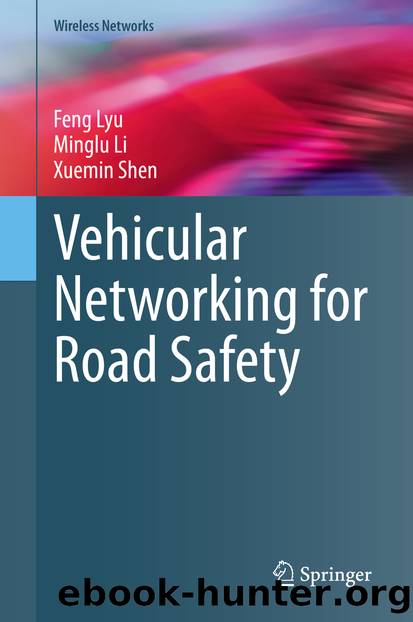Vehicular Networking for Road Safety by Feng Lyu & Minglu Li & Xuemin Shen

Author:Feng Lyu & Minglu Li & Xuemin Shen
Language: eng
Format: epub
ISBN: 9783030512293
Publisher: Springer International Publishing
Similar observations are also held in urban environments. With the space limitation, we just plot the CDFs of delay ratio of individual vehicle in Fig. 4.9. With the results, it can be easily seen that under all resource conditions, SS-MAC can achieve the supreme performance with the lowest delay ratios.
Fig. 4.9CDFs of delay ratio of individual vehicle under different resource conditions in the urban environment. (a) With N = 80. (b) With N = 90. (c) With N = 100
4.5 Summary
In this chapter, we have proposed a novel time slot-sharing MAC, named SS-MAC, to support diverse beaconing rates for road-safety applications in VANETs. In specific, we have first introduced a circular recording queue to perceive occupancy states of time slots in real time, and then devised a distributed time slot sharing approach called DTSS to share a specific time slot efficiently. In addition, we have developed the random index first fit algorithm, named RIFF, to assist vehicles in selecting a suitable time slot for sharing with maximizing the resource utilization of the network. We have theoretically proved the efficacy of DTSS algorithm and evaluated the efficiency of RIFF algorithm by using Matlab simulations. Finally, under various driving scenarios and resource conditions, we have conducted extensive implementation simulations to demonstrate the efficiency of SS-MAC. Particularly, under both highway and urban environments, delay ratios of the overall system and individual vehicle can be significantly reduced with all sorts of resource conditions. Note that, in the previous chapter, we have proposed MoMAC to cope with the time slot collisions caused by vehicular mobilities. In this chapter, SS-MAC has been proposed to enhance the MAC scalability in supporting diverse beaconing rates with efficient resource utilization. They can work collectively to provide collision-free/reliable, scalable, and efficient medium access for moving and distributed vehicles.
References
1.
M. Hadded, P. Muhlethaler, A. Laouiti, R. Zagrouba, L.A. Saidane, TDMA-based MAC protocols for vehicular ad hoc networks: a survey, qualitative analysis, and open research issues. IEEE Commun. Surv. Tutor. 17(4), 2461–2492 (2015)Crossref
Download
This site does not store any files on its server. We only index and link to content provided by other sites. Please contact the content providers to delete copyright contents if any and email us, we'll remove relevant links or contents immediately.
| Automotive | Engineering |
| Transportation |
Whiskies Galore by Ian Buxton(41879)
Introduction to Aircraft Design (Cambridge Aerospace Series) by John P. Fielding(33064)
Small Unmanned Fixed-wing Aircraft Design by Andrew J. Keane Andras Sobester James P. Scanlan & András Sóbester & James P. Scanlan(32743)
Craft Beer for the Homebrewer by Michael Agnew(18140)
Turbulence by E. J. Noyes(7936)
The Complete Stick Figure Physics Tutorials by Allen Sarah(7307)
Kaplan MCAT General Chemistry Review by Kaplan(6866)
The Thirst by Nesbo Jo(6826)
Bad Blood by John Carreyrou(6552)
Modelling of Convective Heat and Mass Transfer in Rotating Flows by Igor V. Shevchuk(6391)
Learning SQL by Alan Beaulieu(6209)
Weapons of Math Destruction by Cathy O'Neil(6143)
Man-made Catastrophes and Risk Information Concealment by Dmitry Chernov & Didier Sornette(5921)
Digital Minimalism by Cal Newport;(5664)
Life 3.0: Being Human in the Age of Artificial Intelligence by Tegmark Max(5474)
iGen by Jean M. Twenge(5366)
Secrets of Antigravity Propulsion: Tesla, UFOs, and Classified Aerospace Technology by Ph.D. Paul A. Laviolette(5309)
Design of Trajectory Optimization Approach for Space Maneuver Vehicle Skip Entry Problems by Runqi Chai & Al Savvaris & Antonios Tsourdos & Senchun Chai(5011)
Pale Blue Dot by Carl Sagan(4912)
